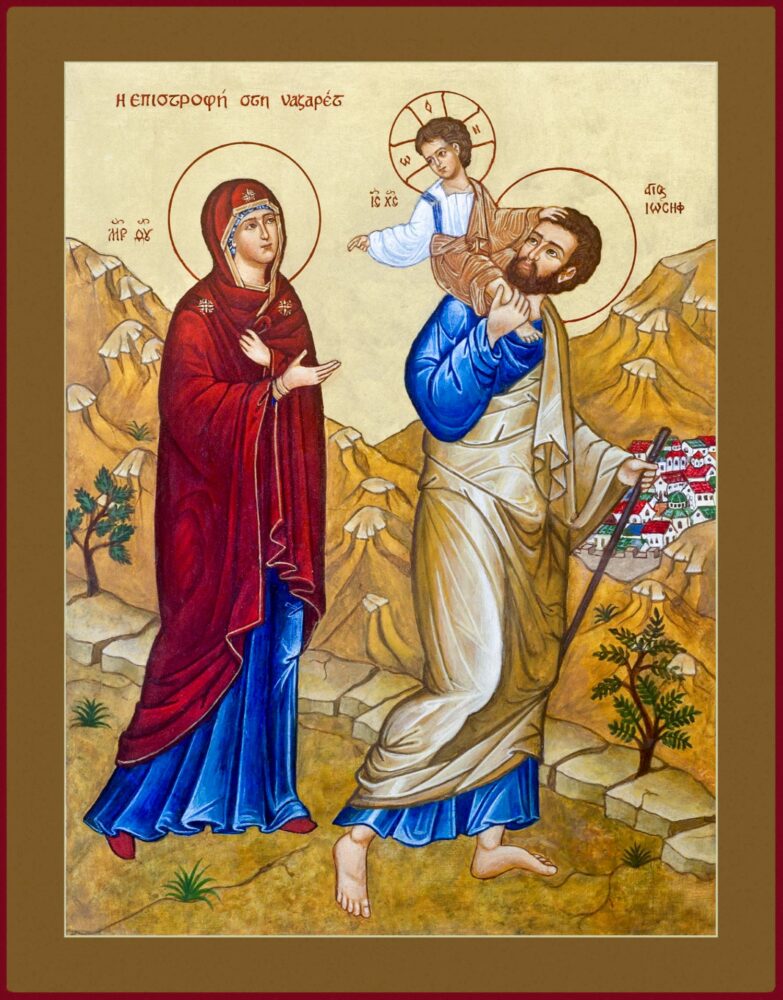
Patrick and Sarah Williams are friends from Texas. A few months ago, we invited them to give a talk via Zoom to our staff and guests. The following is an account of their wonderful presentation.
The two states in life, marriage and consecration, are intimately connected, they told us. Both vocations are responses to Christ’s call to each baptized person to “be perfect as your Heavenly Father is perfect” (Matt. 5:48).
We are all called to a deep exclusivity with God. This ultimate perfection is a nuptial relationship with Christ the Bridegroom. Christian marriage is the image of Christ’s relationship with the Church, as expressed in Paul’s letter to the Ephesians: Husbands, love your wives, as Christ loved the church and gave himself up for her (Eph 5:22-33).
A person choosing the consecrated life is choosing to live this relationship now by following Christ in the evangelical counsels of poverty, chastity and obedience.
Both states of life involve vows or promises. Christ told us that the greatest, the most perfect love is to lay down one’s life for a friend (John 15:13). When a person dies for another, explained Patrick and Sarah, he is taking his whole being and all his future choices, actions and possessions—and giving them up for the sake of another. When one takes a vow, the surrender takes place through time, instead of in one moment.
The evangelical virtues relate to the person in the totality of his or her being.
Poverty has to do with one’s relationship to what is outside oneself; chastity concerns the battle in one’s own body; and obedience conquers the inner self, i.e., the will.
Thus, the evangelical counsels battle the threefold concupiscence identified by St. John (I John 2:16) and referred to by Pope John Paul II in writings of the philosophers Marx (concupiscence of the eyes), Freud (concupiscence of the flesh) and Nietzsche (pride of life).
To understand the nuptial character of the relationship we are called to with Christ, the consecrated person must look to married persons. Through them, he sees what nuptial love looks like.
The married person, on the other hand, looks to the consecrated person to see the “end goal” of his nuptial vows. The married person makes a nuptial vow to his or her spouse which implicitly includes poverty, chastity, and obedience. This vow is the sacrament through which they approach Christ; their spouse will now mediate Christ to them. And all vows require a death to self.
St. John Paul II has a beautiful illustration of this in his play The Jeweler’s Shop. In the second act, we listen to a woman who is experiencing a broken marriage. She longs for a way out, desires to run away from her spouse.
She hears a rumor that the Bridegroom is approaching, and she trembles with the desire to run to him, knowing he is the answer to all her heartaches and expectations. But when she finally comes before him, she is devastated to find that the Bridegroom has the face of her husband.
Running towards Christ meant she was running to her spouse because in marriage, one’s spouse becomes the way to Christ. Even in a happy marriage, this involves crucifixion.
Sarah and Patrick have been married for thirteen years and have nine children. They explained that in their marriage they try to live out the evangelical counsels in a particular, conscious way.
“We live out poverty by putting all our money into one pot, at the service of our family, not considering certain amounts to be ‘mine.’ We don’t have split bank accounts or a personal stash of money. We try not to buy even trivial things (like a candy bar) without the other’s agreement. The money is not my own. It belongs to the family,” said Patrick.
“The same thing goes for time. I don’t go off on my own and exclude the family. I try to include the family in work that I do, as well as in recreation,” he said.
Sarah explained that living out chastity means that all of their sexuality belongs to the other, and they work to shape their desires to the other. This involves guarding themselves for the other and maintaining a receptivity towards the other’s needs.
At social functions, for example, Sarah chooses to spend time with other women instead of the men. “I protect my heart, and I avoid being influenced by sex scenes in television and movies. I want Patrick to be the only one I know,” she said.
“Remembering that obedience is only invoked for the good of the other, we are mutually obedient to each other,” they told us.
For example, Patrick is learning to eat more healthily, like Sarah, and Sarah is learning to exercise regularly, like Patrick. “We try to place ourselves in the same spirit as our spouse, valuing what they value and making their decisions our own. In these ways we experience ‘crucifixion’ where we must conquer our own will for the sake of the other.”
The saints emphasize self-mastery as the key to virtue. This seems to be the foundation of Exodus 90, a three-month program which encourages young men to exercise, fast, and pray as a way of fighting temptation, of unifying the body and soul.
Any step towards self-mastery is meaningful, even if it’s as seemingly trivial as waiting a few minutes before checking a text. Temptation may never truly go away, but that is in God’s hands. Our part is to accept the “thorns in our side” and strive towards virtue.
Offering an example of how this worked in their marriage, Patrick explained that even before meeting Sarah, he realized that if he went to bed earlier and then got up earlier, he would have time to exercise. This gave him increased self-mastery over his body and helped him exercise virtue throughout the day.
Sarah found this stability and self-control most attractive. They continue this routine in their married life, and consider it a key in raising their nine children while still retaining their sanity! They also try to mortify their taste, sleep and use of technology.
“Discipline is kind of a road map,” said Patrick. “Sometimes virtue is just doing the right thing.”
Those who feel called to marriage usually assume that the first step is to meet someone and then to start working on the relationship. Sarah and Patrick, on the contrary, feel it is essential to begin preparing ourselves long before we find that person.
For example, we might have in mind the sort of person we would like to marry someday. But are we the kind of person someone like that would want to marry? What would we need to change in ourselves in order to become that person? “Set as a goal to become that person. If your desires are in line with God’s desires for you, this will lead you to greater virtue,” they said.
People often discount the impact that behavior while dating or during engagement will have on subsequent married life. The truth is that how you are when you first meet and get to know each other is a big part of the married relationship. Studies have shown that cohabitation before marriage significantly increases the chances of divorce. In other words, chastity starts before marriage.
“Consciously living out the evangelical counsels of poverty, chastity and obedience in our marriage, has been a blessing for us and is helping us grow closer to the Lord,” concluded Patrick and Sarah.
Return to Nazareth icon by Marysia Kowalchyk




